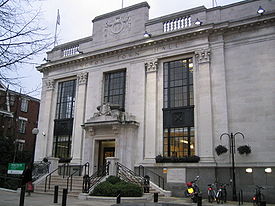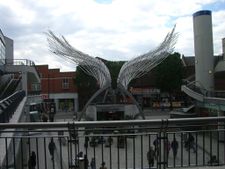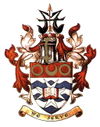London Borough of Islington
| London Borough of Islington | |||
|---|---|---|---|
| — London borough — | |||
|
|||
| Islington shown within Greater London | |||
| Sovereign state | United Kingdom | ||
| Constituent country | England | ||
| Region | London | ||
| Ceremonial county | Greater London | ||
| Status | London borough | ||
| Admin HQ | Upper Street, Islington | ||
| Incorporated | 1 April 1965 | ||
| Government | |||
| - Type | London borough council | ||
| - Body | Islington London Borough Council | ||
| - Leadership | Leader & Cabinet (Labour) | ||
| - Mayor | Cllr Mouna Hamitouche | ||
| - MPs | Jeremy Corbyn Emily Thornberry |
||
| - London Assembly | Jennette Arnold AM for North East | ||
| - EU Parliament | London | ||
| Area | |||
| - Total | 5.7 sq mi (14.86 km2) | ||
| Area rank | 324th (of 326) | ||
| Population (2008 est.) | |||
| - Total | 190,900 | ||
| - Rank | 86th (of 326) | ||
| - Density | 33,272.5/sq mi (12,846.6/km2) | ||
| - Ethnicity[1] | 58.4% White British 4.5% White Irish 12.3% Other White 1.2% White & Black Caribbean 0.7% White & Black African 1.1% White & Asian 1.2% Other Mixed 2.2% Indian 0.8% Pakistani 2.3% Bangladeshi 1.0% Other Asian 4.2% Black Caribbean 5.2% Black African 1.0% Other Black 2.3% Chinese 1.7% Other |
||
| Time zone | GMT (UTC0) | ||
| - Summer (DST) | BST (UTC+1) | ||
| Postcodes | {{{postcode_areas}}} | ||
| Police force | Metropolitan Police | ||
| Website | [LB Islington LB Islington] | ||
The London Borough of Islington (pronunciation) is a London borough in Inner London. It was formed in 1965 by merging the former metropolitan boroughs of Islington and Finsbury. The borough contains two Westminster parliamentary constituencies, Islington North and Islington South & Finsbury.
Contents |
Etymology
Islington was originally named by the Saxons Giseldone (1005), then Gislandune (1062). The name means 'Gīsla's hill' from the Old English personal name Gīsla and dun 'hill', 'down'. The name then later mutated to Isledon, which remained in use well into the 17th century when the modern form arose.[2] In medieval times, Islington was just one of many small manors in the area, along with Bernersbury, Neweton Berewe or Hey-bury, and Canonesbury (Barnsbury, Highbury and Canonbury - names first recorded in the 13th and 14th centuries). "Islington" came to be applied as the name for the parish covering these villages, and was the name chosen for the Metropolitan Borough of Islington, on its formation in 1899. On the merger with Finsbury, to form the modern borough this name came to be applied to the whole borough.
Districts of Islington
The borough includes the areas:
- Angel
- Archway
- Barnsbury
- Canonbury
- Clerkenwell
- Finsbury
- Finsbury Park
- Highbury
- Holloway
- Islington
- Kings Cross
- Nag's Head
- Newington Green
- Pentonville
- St Luke's
- Tufnell Park
- Old Street
- Mildmay
-
- see also Islington parks and open spaces
Wards
- Barnsbury
- Bunhill
- Caledonian
- Canonbury
- East Canonbury
- Newington Green
- Clerkenwell
- Finsbury Park
- Highbury East
- Highbury West
- Hillrise
- Holloway
- Junction
- Mildmay
- Saint Georges
- Saint Marys
- Saint Peters
- Tollington
Transport

Islington has a wide variety of transportation services, with direct connections to the suburbs and the City and West End. Islington also has over 8 tube stations with connections by the tube to all around London.
Buses
| Bus Number | Destination | Operator |
|---|---|---|
| 4 | Waterloo - Archway | Metroline |
| 10 | King's Cross - Hammersmith | First |
| 17 | London Bridge - Archway | Metroline |
| 19 | Battersea Bridge - Finsbury Park | Arriva |
| 21 | Lewisham - Newington Green via Southgate Road | London Central |
| 29 | Trafalgar Square - Wood Green | Arriva |
| 30 | Marble Arch - Hackney Hick via Highbury & Islington | East London |
| 38 | Victoria - Clapton Pond | Arriva |
| 41 | Archway - Tottenham Hale | Arriva |
| 43 | London Bridge - Friern Barnet | Metroline |
| 46 | Hampstead Heath - Farrindon Street | Metroline |
| 55 | Oxford Circus - Leyton | East London |
| 56 | West Smithfield - Whipps Cross | East London |
| 73 | Victoria - Seven Sisters | Arriva |
| 76 | Waterloo (County Hall) - Tottenham Town Hall via Bank, Moorgate, Finsbury, Southgate Road, Stoke Newington | Arriva |
| 91 | Trafalgar Square - Crouch End | First |
| 134 | Tottenham Court Road - North Finchley via Camden Town, Archway, Highgate | Metroline |
| 141 | London Bridge - Palmers Green via Moorgate, City Road, New North Road, Southgate Road, Newington Green, Highbury East, Green Lanes, Wood Green | Arriva |
| 143 | Archway - Brent Cross | Metroline |
| 153 | Liverpool Street - Finsbury Park | HT |
| 205 | Mile End - Paddington via Liverpool Street, City Road, Angel, King's Cross, Euston, Baker Street, Marylebone | Metroline |
| 210 | Finsbury Park - Brent Cross via Archway, Highgate, Golders Green | Metroline |
| 214 | Liverpool Street Station - Highgate Village via City Road, Angel, King's Cross, Camden Town, Kentish Town, Highagte | Metroline |
| 243 | Waterloo - Wood Green via Aldwych, Holborn, Old Street, Kingsland Road | Arriva |
| 253 | Hackney Central Station - Euston via Holloway Nags Head | Arriva |
| 263 | Archway Station - Barnet Hopital via Highgate, Finchley, Barnet | Metroline |
| 271 | Moorgate - Highgate Village via City Road, Old St Stn, New North Road, Highbury & Islington Stn, Holloway, Archway, Highgate | Metroline |
| 274 | Lancaster Gate Station - Islington Angel via Camden Town, Regents Park, Baker Street | Metroline |
| 277 | Highbury & Islington Station - Leamouth via Dalston Junction, Canary Wharf | East London |
| 390 | Notting Hill Gate - Archway via Tottenham Court Road, Euston, King's Cross, Camden Town | Metroline |
| 393 | Chalk Farm Station - Stoke Newington via Highbury, Holloway, Camden | Arriva |
| 394 | Hackney - Islington via Angel, City Road, New North Road, Hoxton, Haggerston, London Fields | HC |
| 476 | Euston - Northumberland Park via King's Cross, Angel, Essex Road, Newington Green, Stoke Newington, Seven Sisters, Tottenham | First |
| 812 | Angel - Old Street via Southgate Road, Downham Road, Almorah Road, Essex Road | CT Plus |
London Underground
There are many Underground stations in the borough:
- Angel
- Archway
- Arsenal
- Caledonian Road
- Finsbury Park
- Highbury and Islington
- Holloway Road
- Old Street
- Tufnell Park
These stations principally serve the Piccadilly, Victoria and Northern lines.
Railway stations
There are also quite a few railway stations within the borough, they are as follows:
- Caledonian Road & Barnsbury
- Highbury and Islington
- Canonbury
- Upper Holloway
- Crouch Hill
- Drayton Park
- Essex Road
- Finsbury Park
Major public and private bodies in Islington
There are two prisons in Islington, a male prison, HM Prison Pentonville and a women's prison Holloway, that held many suffragettes. Some of the Notable former inmates of Pentonville prison have been
- Hawley Harvey Crippen (Dr Crippen) was hanged in the prison in 1910 after being found guilty of murdering his wife.
- Frederick Seddon the poisoner, was hanged in the prison in 1912.
- John Christie was hanged in the prison in 1953 after having been convicted of murdering his wife.
- Charles Peace, notorious burglar and murderer.
- Timothy Evans, wrongfully accused co-tenant of John Christie.
- Neville Heath was hanged in the prison in 1946 after having been convicted of murdering two women.
- Simon Dee, a radio/television personality, served 28 days for non-payment of council tax on his former Chelsea home that he had not shared with his first wife since 1971/2
- Taki Theodoracopulos, gossip columnist for The Spectator, was imprisoned in Pentonville for three months in 1984 on a cocaine possession charge. He wrote a book about the experience titled Nothing to Declare.
- David Irving, historian.
- John Alford spent six weeks in Pentonville in 1999 after selling illegal drugs to a reporter.
- Hugh Cornwell of The Stranglers served a sentence for drug possession
- Pete Doherty of The Libertines and Babyshambles spent four nights in Pentonville in February 2005 while unable to make bail on charges which were later dropped. He subsequently wrote a song about the prison, named "Pentonville", which is on the Babyshambles album Down In Albion.
- Blake Fielder-Civil, husband of Amy Winehouse, was held at Pentonville for grievous bodily harm and attempting to pervert the course of justice in 2008.
- Boy George, in 2009, for the assault and false imprisonment of a male escort.
Cultural attractions and institutions in Islington

- Almeida Theatre
- Pleasance Theatre Islington
- Courtyard Theatre
- Emirates Stadium (and the former Arsenal Stadium at Highbury)
- Islington N1 Centre
- The Estorick Collection of Modern Italian Art in Canonbury Square
- Hen and Chickens Theatre
- Islington Arts Factory, in Parkhurst Road,
- London Canal Museum, located in New Wharf Road, King's Cross
- Islington Museum, located at Finsbury Library
- Islington Local History Centre, located at Finsbury Library
- The King's Head Theatre
- Sadler's Wells Theatre
- Technology Mile - wireless access throughout Upper Street and Holloway Road.[3]
- Union Chapel
- Peter Benenson House, headquarters of Amnesty International
- Little Angel Theatre a puppet theatre and producer of the Suspense Puppetry Festival of London.
- VUE Cinema Located inside the N1 center
Farm
Holloway in Islington is home to Freightliners City Farm which is one of the many city farms throughout London. The farm, which isn't like an industrial farm, contains a wide range of animals from rabbits to cows to chickens and pigs all free for the public to view.
Demographics
| Population | ||
|---|---|---|
| Year | Pop. | %± |
| 1801 | 65,721 | — |
| 1811 | 83,679 | 27.3% |
| 1821 | 108,333 | 29.5% |
| 1831 | 137,271 | 26.7% |
| 1841 | 162,717 | 18.5% |
| 1851 | 214,090 | 31.6% |
| 1861 | 266,010 | 24.3% |
| 1871 | 317,930 | 19.5% |
| 1881 | 369,850 | 16.3% |
| 1891 | 397,799 | 7.6% |
| 1901 | 405,301 | 1.9% |
| 1911 | 412,944 | 1.9% |
| 1921 | 401,054 | −2.9% |
| 1931 | 389,513 | −2.9% |
| 1941 | 324,143 | −16.8% |
| 1951 | 269,743 | −16.8% |
| 1961 | 232,258 | −13.9% |
| 1971 | 200,022 | −13.9% |
| 1981 | 157,512 | −21.3% |
| 1991 | 173,384 | 10.1% |
| 2001 | 175,787 | 1.4% |
| 2009 | 200,000 | 13.8% |
| Source: A Vision of Britain through time | ||
In 1801, the civil parishes that form the modern borough had a total population of 65,721. This rose steadily throughout the 19th century, as the district became built up; exceeding 200,000 in the middle of the century. When the railways arrived the rate of population growth increased — reaching nearly 400,000 by the turn of the century; with the Metropolitan Borough of Finsbury particularly suffering deprivation, poverty and severe overcrowding. The increase in population peaked before World War I, falling slowly in the aftermath until World War II began an exodus from London towards the new towns under the Abercrombie Plan for London (1944). The decline in population reversed in the 1980s, but it remains below its 1971 level.
According to the 2001 census Islington has a population of 175,797. It is 75% White, 6% Black African, 5% Black Caribbean and 2% Bangladeshi. 32% of the borough's residents are owner–occupiers.
Education
Universities
The London Borough of Islington is home to two higher education institutions:—
- City University, London at Northampton Square, formerly the Northampton Institute, founded in 1894; and
- London Metropolitan University, North Campus on the Holloway Road, formed from the merger of the University of North London and London Guildhall University in 2002. The University of North London was founded in 1896 as the Northern Polytechnic Institute.
Colleges
The borough also currently contains two colleges of further education:—
- City and Islington College; and
- Westminster Kingsway College (while major improvement works are carried out at King's Cross).
Schools
The borough currently maintains 47 primary schools, 10 secondary schools, three special schools and five Pupil Referral Units. In 2000, Cambridge Education Associates, a private firm, took over the management of the Islington's state schools from the local education authority.[4]
In popular culture
In Douglas Adams' The Hitchhiker's Guide To The Galaxy, three of the four main characters (Arthur Dent, Trillian, and Zaphod Beeblebrox) first met at a "fancy dress party" at a flat in Islington.
- Brittany Murphy's character in Love and Other Disasters almost gets married at Islington Town Hall (she calls it off in the middle of the ceremony).
References
- ↑ Data Management and Analysis Group, Greater London Authority, Demography Update October 2007, (2007)
- ↑ 'Islington: Growth', A History of the County of Middlesex: Volume 8: Islington and Stoke Newington parishes (1985), pp. 9-19 accessed: 13 March 2007
- ↑ Technology Mile (Internet access) accessed 15 Mar 2007
- ↑ BBC education
External links
|
||||||||||||||||||||||
|
||||||||||||||

